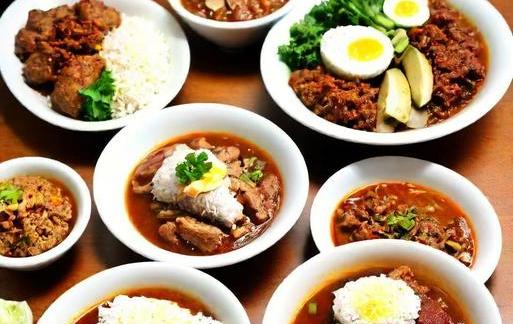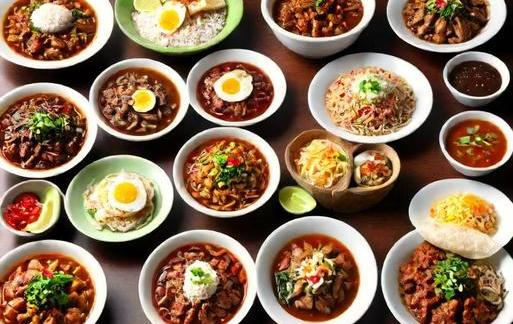- You are here:
- Home »
- Food
- » [REVEALED] Filipino Foods That Start With S
[REVEALED] Filipino Foods That Start With S
Note: This page contains affiliate links.
As an Amazon Associate, I earn from qualifying purchases when you click on the link, but you are not charged extra.
Filipino cuisine is a rich tapestry of flavors, influenced by a diverse history and a wide array of local ingredients. From savory to sweet, Filipino dishes never fail to captivate the taste buds. In this article, we delve into a specific aspect of Filipino gastronomy – foods that start with the letter "S." Whether you’re a culinary enthusiast or simply curious about Filipino culture, this exploration promises a delightful journey through some of the most iconic and mouth-watering dishes.
Contents
List Of Filipino Foods That Start With S

Sinigang
Description:
Sinigang stands out as one of the quintessential Filipino soups, celebrated for its savory and sour taste. The broth, which forms the heart of Sinigang, is flavored with tamarind, creating a unique tanginess. This dish typically includes various vegetables, such as water spinach (kangkong), radishes (labanos), and string beans (sitaw). Meat options range from pork to shrimp, providing a versatile and comforting culinary experience.
Preparation:
To prepare Sinigang, tamarind is boiled to extract its juice, forming the base of the soup. The chosen meat is then added, followed by a medley of vegetables. The result is a harmonious blend of flavors that captures the essence of Filipino comfort food.
Sisig
Description:
Sisig is a sizzling and flavorful dish that has earned its place as a beloved Filipino appetizer. Originating from Pampanga, this dish is a celebration of bold and zesty flavors. Traditionally made from parts of a pig’s head, such as cheeks and ears, Sisig has evolved to include various protein options like chicken and tofu. The dish is renowned for its crunchy texture, thanks to meticulous grilling and broiling.
Preparation:
To prepare Sisig, the chosen protein is first boiled and then grilled to achieve a crispy texture. It is then finely chopped and mixed with a blend of onions, garlic, soy sauce, and calamansi juice. The mixture is finally placed on a sizzling plate, creating an enticing aroma that signals the arrival of this delectable dish.
Sinampalukang Manok
Description:
Sinampalukang Manok is another sour soup that boasts a distinctive Filipino taste. This dish showcases the culinary prowess of Filipinos in blending sourness with savory elements. The sourness is derived from tamarind leaves, providing a different profile compared to the more common Sinigang. Chicken is the star of this dish, contributing to its heartiness and making it a favorite comfort food.
Preparation:
The preparation of Sinampalukang Manok involves boiling chicken with tamarind leaves, creating a flavorful broth. Additional ingredients such as string beans, water spinach, and green chili peppers are included for added texture and taste. The result is a warm and invigorating soup that captures the essence of Filipino culinary ingenuity.
Suman
Description:
Suman is a Filipino delicacy that showcases the country’s creativity in transforming simple ingredients into a delightful treat. This rice cake is made by wrapping glutinous rice in banana leaves and then steaming it to perfection. Suman comes in various shapes and sizes, and its sweet and sticky texture makes it a popular choice for breakfast or dessert.
Preparation:
To prepare Suman, glutinous rice is soaked and mixed with coconut milk and sugar. The mixture is then placed on banana leaves, rolled into cylindrical shapes, and secured with strings. The wrapped rice is steamed until fully cooked, resulting in a delectable and fragrant rice cake. Suman is often served with a side of sugar or a drizzle of coconut caramel for an extra touch of sweetness.
Salabat
Description:
Salabat, often referred to as ginger tea, is a warm and soothing beverage enjoyed by many Filipinos. Beyond its comforting taste, Salabat is believed to have medicinal properties, particularly in alleviating cold symptoms. This concoction is a staple during rainy seasons or whenever a boost of warmth and vitality is needed.
Preparation:
The preparation of Salabat involves boiling fresh ginger slices in water, sometimes with added honey or calamansi juice for sweetness and flavor. The resulting tea is not only a delicious remedy for colds but also a cultural symbol of Filipino hospitality, often served to guests as a gesture of warmth and care.
Sarsiado
Description:
Sarsiado is a Filipino dish that highlights the country’s love for incorporating tomatoes and eggs into savory dishes. Typically made with fish, Sarsiado features a flavorful tomato-based sauce with the addition of beaten eggs, creating a unique and satisfying meal. The dish is an explosion of colors and tastes, reflecting the vibrancy of Filipino culinary traditions.
Preparation:
To prepare Sarsiado, fish is first pan-fried until golden brown. A rich tomato sauce, usually made with garlic, onions, and tomatoes, is then poured over the fish. Beaten eggs are added to the mix, creating a thick and luscious sauce that coats the fish. Sarsiado is often served with steamed rice, providing a well-balanced and hearty dining experience.
Sotanghon
Description:
Sotanghon, also known as cellophane noodles, is a popular ingredient in Filipino cuisine, often featured in soups and stir-fried dishes. Made from mung bean starch, these transparent noodles are prized for their slippery texture and ability to absorb the flavors of the dishes they are cooked with. Sotanghon is a versatile ingredient that adds a delightful twist to many Filipino recipes.
Preparation:
The preparation of Sotanghon involves soaking the noodles in water until they become soft and translucent. They are then added to various dishes, such as chicken soup or stir-fried vegetables, providing a unique texture and absorbing the savory goodness of the surrounding ingredients. Sotanghon is a favorite not only for its taste but also for its ability to elevate the overall dining experience.
Suman Sa Lihiya
Description:
Suman sa Lihiya is a type of rice cake that stands out for its distinctive flavor and preparation method. The inclusion of lye water, or lihiya, in the recipe gives the rice cake its unique taste and aroma. This delicacy is often enjoyed with grated coconut or a drizzle of coconut caramel, adding layers of sweetness and richness to the overall experience.
Preparation:
To prepare Suman sa Lihiya, glutinous rice is mixed with water and lihiya, giving it a yellowish tint. The mixture is then wrapped in banana leaves and steamed until fully cooked. The result is a chewy and flavorful rice cake that captivates the palate with its unique combination of ingredients. Suman sa Lihiya is a testament to the creativity and ingenuity of Filipino culinary traditions.
Shakoy
Description:
Shakoy, often referred to as Filipino twisted doughnuts, is a beloved snack appreciated for its simplicity and delightful sweetness. These golden, twisted delights are a popular choice for breakfast or merienda (afternoon snack) and are enjoyed by people of all ages. The crispiness on the outside and softness on the inside make Shakoy an irresistible treat.
Preparation:
To prepare Shakoy, a simple dough is made from flour, sugar, and yeast. The dough is then allowed to rise before being rolled, twisted, and fried until golden brown. The finished product is coated with sugar, creating a sweet and crunchy exterior that contrasts perfectly with the soft and airy interior. Shakoy is often enjoyed with a cup of coffee or hot chocolate, making it a delightful addition to Filipino snack time.
Filipino foods that start with "S" offer a fascinating glimpse into the diverse and flavorful world of Filipino cuisine. From hearty soups like Sinigang and Sinampalukang Manok to sweet delicacies like Suman and Shakoy, these dishes showcase the creativity, resourcefulness, and love for bold flavors that define Filipino cooking. Each dish tells a story, weaving together the cultural tapestry of the Philippines and leaving a lasting impression on those fortunate enough to savor these culinary delights. As you explore the rich array of Filipino foods, the ones that start with "S" will undoubtedly leave you with a taste of the warmth and hospitality that characterizes Filipino culture.
Significance

The Philippines is a melting pot of diverse cultures, and its cuisine reflects this rich tapestry of influences. Among the myriad flavors and dishes that define Filipino cuisine, those starting with the letter "S" hold a special place. In this comprehensive exploration, we delve into the significance, categories, common themes, and intriguing facts surrounding Filipino foods that commence with the letter "S."
Understanding the significance of Filipino foods that start with "S" requires a closer look at the culinary history and cultural heritage of the Philippines. The letter "S" in Filipino cuisine represents a symphony of tastes, textures, and traditions that have evolved over centuries. From street food stalls to elaborate feasts, these dishes have become an integral part of Filipino identity.
The significance also lies in the versatility of these "S" dishes, with many of them adapting to local ingredients and regional variations. Whether enjoyed during festive celebrations or daily meals, these foods contribute to the communal spirit that defines Filipino social gatherings.
Category-Related

Filipino foods starting with "S" can be broadly categorized into various groups, each showcasing the diversity of the country’s culinary landscape. From savory to sweet, from street snacks to elaborate entrees, these categories offer a glimpse into the wide array of flavors present in Filipino cuisine.
1. Savory Delights
- Sinigang: A sour tamarind-based soup, sinigang is a Filipino comfort food that features a harmonious blend of meat, vegetables, and a distinctive tangy broth.
- Sisig: Hailing from Pampanga, sisig is a sizzling dish made from chopped pig’s face and ears, seasoned with calamansi, onions, and chili peppers.
- Sinangag: This garlic-fried rice is a staple accompaniment to many Filipino meals, offering a fragrant and flavorful side dish.
2. Street Food Staples
- Fishballs: Found at almost every street corner, fishballs are deep-fried snacks made from fish paste and served with a variety of dipping sauces.
- Siomai: Dim sum lovers rejoice, as siomai – steamed or fried dumplings filled with pork or shrimp – has become a popular street food item.
3. Sweet Indulgences
- Sapin-sapin: A layered rice cake made with glutinous rice and coconut milk, sapin-sapin is not only a delicious dessert but also a colorful and vibrant one.
- Suman: This sticky rice delicacy, wrapped in banana leaves, is often enjoyed with coconut milk and sugar, creating a sweet and satisfying treat.
Common Themes
Despite the diversity within the category of Filipino foods starting with "S," there are common themes that unite these dishes. These themes are deeply rooted in Filipino culture, reflecting the values and traditions that have shaped the nation’s culinary heritage.
1. Community And Sharing
Filipino meals are often communal affairs, with dishes starting with "S" being no exception. Whether it’s a pot of sinigang shared among family members or a plate of siomai passed around at a street food stall, the act of sharing food is a fundamental aspect of Filipino culture.
2. Influence Of Indigenous Ingredients
Many "S" dishes showcase the Philippines’ abundant natural resources. Coconut, rice, and an array of tropical fruits and vegetables are often key components, highlighting the importance of indigenous ingredients in Filipino cooking.
3. Adaptation And Fusion
Filipino cuisine is a dynamic blend of indigenous flavors and foreign influences. Dishes starting with "S" often showcase this fusion, with culinary elements borrowed from Chinese, Spanish, and Malay cuisines, among others.
Interesting Facts
Exploring the realm of Filipino foods that start with "S" unveils a treasure trove of interesting facts, providing insights into the origins, cultural significance, and unique characteristics of these dishes.
1. Sisig’s Evolution
Sisig, now a beloved Filipino dish, has an interesting origin story. Initially considered a poor man’s dish, it was invented by Lucia Cunanan in Pampanga during the 1970s. Over time, it evolved from a simple, humble dish into a culinary sensation enjoyed by people from all walks of life.
2. Sapin-sapin’s Symbolism
Sapin-sapin is not just a delicious dessert; it also holds cultural symbolism. The vibrant, multicolored layers of sapin-sapin are said to represent the diversity and unity of the Filipino people. Each layer, distinct in flavor and color, contributes to the harmonious whole – a metaphor for the nation’s multicultural society.
3. Street Food Culture
The prominence of street food, including fishballs and siomai, in Filipino cuisine reflects the nation’s vibrant street food culture. Street vendors, known as "manglalako," play a crucial role in making these affordable and accessible snacks available to people from all walks of life.
Conclusion
In the tapestry of Filipino cuisine, the foods that start with "S" weave a narrative of flavors, traditions, and community. From the savory delights of sinigang and sisig to the sweet indulgences of sapin-sapin and suman, these dishes showcase the richness of Filipino culinary heritage. The common themes of community, indigenous ingredients, and adaptation underscore the cultural significance of these foods.
As we savor the diverse and delectable "S" dishes, we not only indulge our taste buds but also immerse ourselves in the stories and histories that have shaped Filipino food. Through shared meals and the act of breaking bread together, these dishes foster a sense of belonging and celebration, embodying the spirit of Filipino hospitality and warmth. So, the next time you encounter Filipino foods that start with "S," savor not just the flavors but the cultural tapestry they represent.


